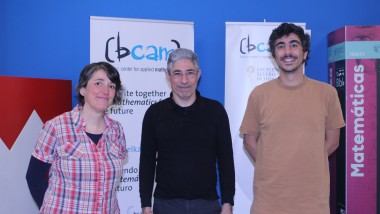BCAM participates in a key international study on brain evolution, published in Science Magazine
- The study explores a fundamental question in neuroscience: Do the brains of vertebrates-including mammals, birds and reptiles-evolve along separate trajectories or does evolution direct them towards a common functional design?
- BCAM scientist and research leader at the Krembil Research Institute (Canada), Maurizio De Pittà, is the co-lead author of the groundbreaking study coordinated by Fernando García-Moreno (Achucarro - Basque Neuroscience Centre). The study is the result of multidisciplinary work in the recording and modelling of embryonic cells that has been possible thanks to the international collaboration of BCAM and Achucarro with researchers from CICBiogune, the National Centre for Cardiovascular Research (CNIC), the Centre for Biomedical Research Network on Cardiovascular Diseases (CIBERCV), the University of Murcia and SciLifeLab (Sweden).
BCAM along with BERC Center Achucarro (Basque Centre for Neuroscience), CIC bioGUNE, (Cooperative Research Center in Biosciences), the Spanish National Center for Cardiovascular Research (CNIC), the Biomedical Research Networking Center on Cardiovascular Diseases (CIBERCV), the University of Murcia, and SciLifeLab (Sweden) is part of a pioneering international study on brain evolution, published in the prestigious scientific journal SCIENCE.
Titled "Evolutionary Convergence of Sensory Circuits in the Pallium of Amniotes," the study represents a significant breakthrough in the field of evolutionary neuroscience.
A multidisciplinary collaboration across Spain, Sweden, and Canada
This research is the result of years of multidisciplinary collaboration among scientists from Spain, Sweden, and Canada. BCAM researcher Maurizio De Pittà is the co-lead author of this groundbreaking study, which was coordinated by Fernando García-Moreno (Achucarro) and involved researchers from CICBiogune, the Spanish National Center for Cardiovascular Research (CNIC), the Biomedical Research Networking Center on Cardiovascular Diseases (CIBERCV), the University of Murcia, and SciLifeLab (Sweden).
The Goal: A Key Question in Brain Evolution
The study tackles a fundamental question in neuroscience:
Do vertebrate brains—mammals, birds, and reptiles—develop independently, or does their evolution converge toward a common functional design?
To address this question, the team employed an innovative approach that combined neurogenic, transcriptomic, and mathematical analyses across three representative species: chicken, mouse, and gecko.
Key Findings
The research uncovered surprising differences and similarities in the sensory circuits of the pallium among the studied species:
• Developmental diversification: Sensory circuits in the pallium evolved independently, following distinct neurogenic rules in mice compared to chickens and geckos.
• Cellular and molecular diversification vs. conservation: While excitatory glutamatergic neurons evolved divergently, inhibitory GABAergic neurons remained highly conserved across species, highlighting their fundamental role in sensory circuits.
• Mathematical modeling: Contributed by BCAM scientist Maurizio De Pittà, the study showed that, despite distinct neurogenic programs, bird and mammal brains evolve towards similar functional constraints (eigendynamics). This supports the hypothesis of a convergent evolution of sensory circuits in vertebrate pallium.
Key Conclusions
This study provides strong evidence that high-level sensory processing circuits in amniotes evolved independently but converged into a similar functional design. Moreover, it contributes to a long-standing debate in evolutionary biology, demonstrating that differences in developmental rules, transcriptomic profiles, and progenitor cells highlight the evolutionary flexibility of the pallium. These findings open new research avenues into how vertebrate brains have adapted to different environments and functional demands.
A milestone in mathematical neuroscience research
The publication of this study in SCIENCE highlights BCAM’s leadership in the field of applied mathematical research, both nationally and internationally. It also reinforces the role of these research centers and their scientists as a hub for international and multidisciplinary collaboration in solving fundamental questions about brain evolution.
Related news
About the center
About the center




